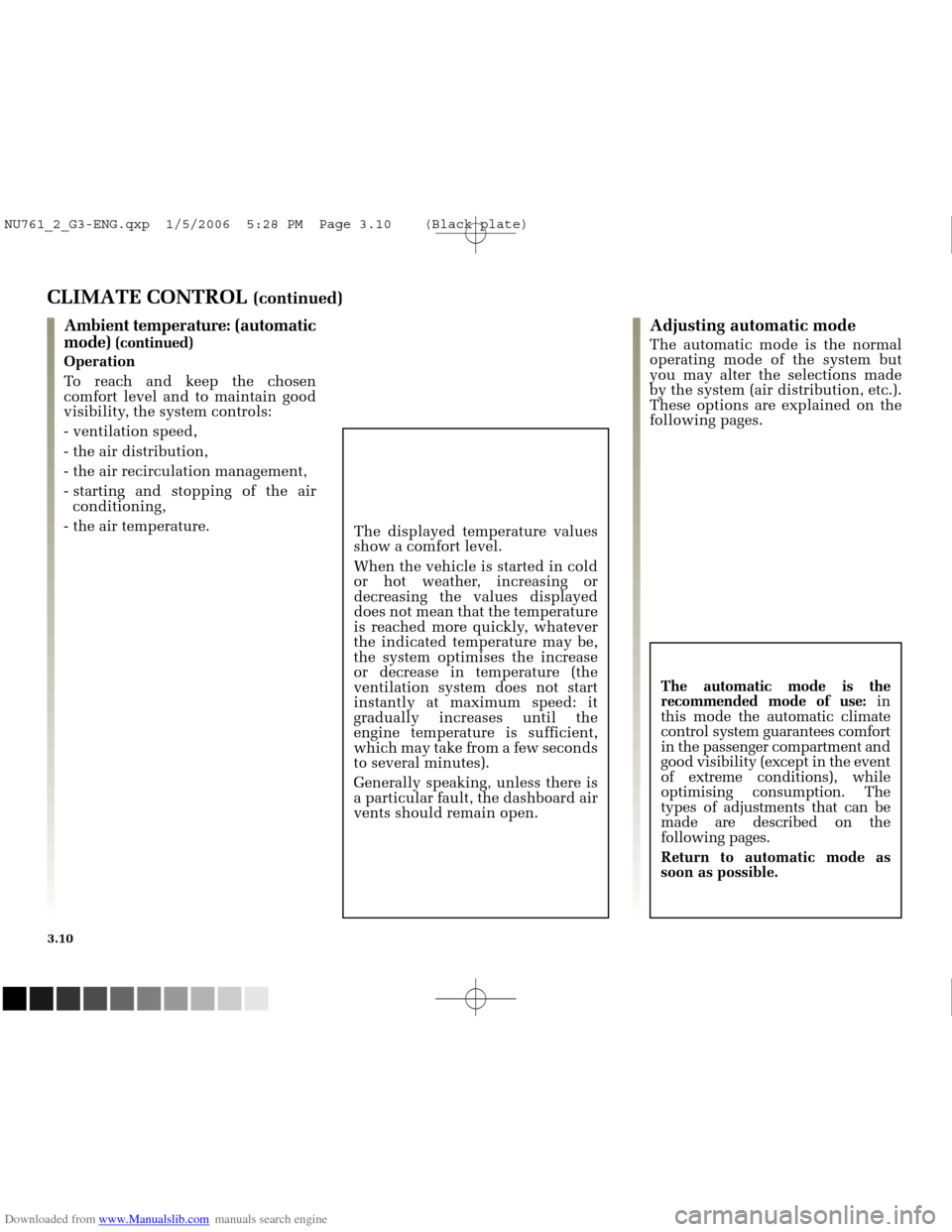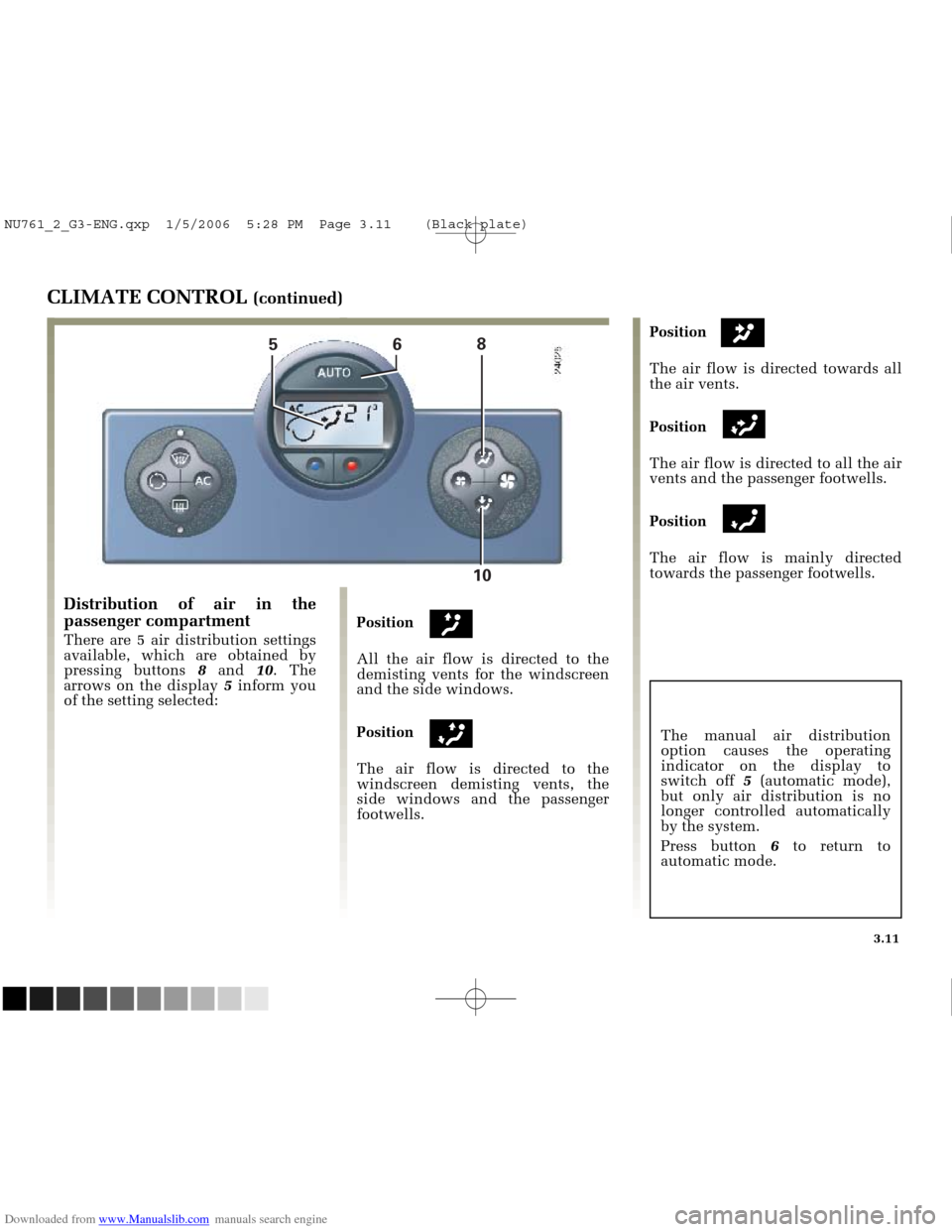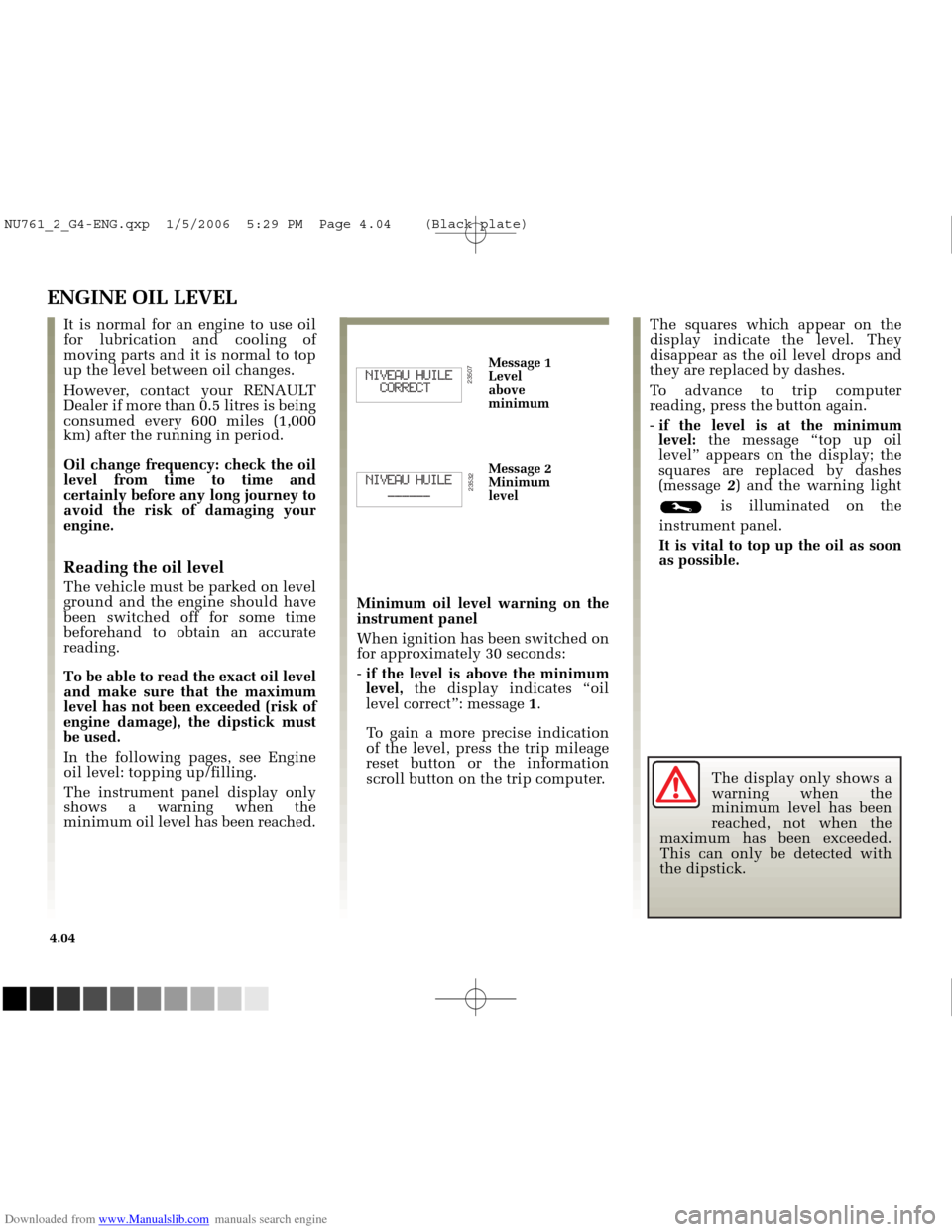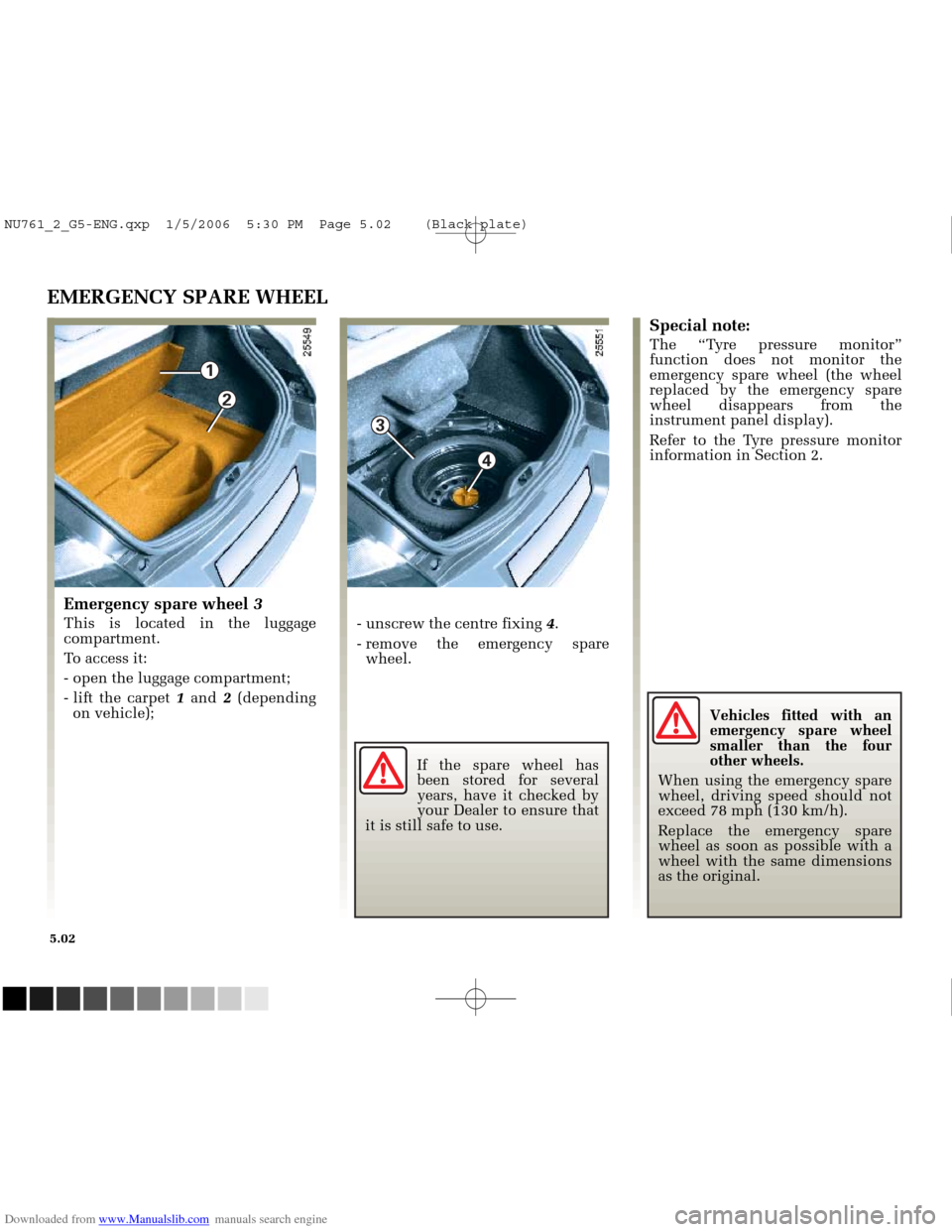Page 148 of 250

Downloaded from www.Manualslib.com manuals search engine
NU761_2_G3-FRA.qxd 4/11/05 10:51 Page 3.10
3.10
CLIMATE CONTROL (continued)
Ambient temperature: (automatic
mode)
(continued)
Operation
To reach and keep the chosen
comfort level and to maintain good
visibility, the system controls:
- ventilation speed,
- the air distribution,
- the air recirculation management,
- starting and stopping of the air conditioning,
- the air temperature.Adjusting automatic mode
The automatic mode is the normal
operating mode of the system but
you may alter the selections made
by the system (air distribution, etc.).
These options are explained on the
following pages.
The displayed temperature values
show a comfort level.
When the vehicle is started in cold
or hot weather, increasing or
decreasing the values displayed
does not mean that the temperature
is reached more quickly, whatever
the indicated temperature may be,
the system optimises the increase
or decrease in temperature (the
ventilation system does not start
instantly at maximum speed: it
gradually increases until the
engine temperature is sufficient,
which may take from a few seconds
to several minutes).
Generally speaking, unless there is
a particular fault, the dashboard air
vents should remain open.
The automatic mode is the
recommended mode of use: in
this mode the automatic climate
control system guarantees comfort
in the passenger compartment and
good visibility (except in the event
of extreme conditions), while
optimising consumption. The
types of adjustments that can be
made are described on the
following pages.
Return to automatic mode as
soon as possible.
NU761_2_G3-ENG.qxp 1/5/2006 5:28 PM Page 3.10 (Black plate)
Page 149 of 250

Downloaded from www.Manualslib.com manuals search engine
13 12 1110
568
NU761_2_G3-FRA.qxd 4/11/05 10:51 Page 3.11
3.11
CLIMATE CONTROL (continued)
Distribution of air in the
passenger compartment
There are 5 air distribution settings
available, which are obtained by
pressing buttons 8and 10. The
arrows on the display 5inform you
of the setting selected: Position
All the air flow is directed to the
demisting vents for the windscreen
and the side windows.
Position
The air flow is directed to the
windscreen demisting vents, the
side windows and the passenger
footwells.
Positionm
The air flow is directed towards all
the air vents.
Position
The air flow is directed to all the air
vents and the passenger footwells.
Position
The air flow is mainly directed
towards the passenger footwells.
The manual air distribution
option causes the operating
indicator on the display to
switch off
5(automatic mode),
but only air distribution is no
longer controlled automatically
by the system.
Press button 6to return to
automatic mode.
NU761_2_G3-ENG.qxp 1/5/2006 5:28 PM Page 3.11 (Black plate)
Page 150 of 250

Downloaded from www.Manualslib.com manuals search engine
13 12 1111
56
93
NU761_2_G3-FRA.qxd 4/11/05 10:51 Page 3.12
3.12
CLIMATE CONTROL (continued)
Varying the ventilation speed
In automatic mode, the system uses
the most suitable amount of air to
reach and maintain the desired
comfort level.
Exit automatic mode by pressing
buttons 9and 11.
These buttons allow you to increase
or decrease ventilation speed.
Switching air conditioning on
or off
In automatic mode, the system
switches the air conditioning system
on or off, depending on the exterior
weather conditions.
Exit automatic mode by pressing
button 3: the AUTO indicator on
display 5switches off.
Button 3activates (indicator light on
the display lit) or deactivates
(indicator light off) the air
conditioning function. Note:
the “clear view” function
automatically activates the air
conditioning system (indicator light
on). Press button 6to return to
automatic mode.
In automatic mode, in cold
weather, the ventilation will not
start immediately at maximum
power but will increase
progressively until the engine
temperature is warm enough to
heat the passenger compartment
air. This may take from a few
seconds to several minutes.
NU761_2_G3-ENG.qxp 1/5/2006 5:28 PM Page 3.12 (Black plate)
Page 152 of 250
Downloaded from www.Manualslib.com manuals search engine
12 613 12 11
NU761_2_G3-FRA.qxd 4/11/05 10:51 Page 3.14
3.14
CLIMATE CONTROL (continued)
This function rapidly demists/de-
ices the windscreen, the front side
windows and the door mirrors
(depending on the vehicle).
It imposes automatic operation of
the air conditioning, inhibits
recirculation and activates heating of
the rear screen (indicator light 13).
Press button 12if you do not want
rear screen heating to be activated,
indicator light 13goes out.
“Clear view” Function
Press button 1, operating indicator 2
lights up.
The AUTO button indicator light
(on the display) switches off. Note.:
if you wish to reduce the air
flow (which may produce a certain
amount of noise in the passenger
compartment), press button 11.
To exit this function , press either:
- button 1again,
- button 6 (the AUTO warning light
on the display illuminates).
NU761_2_G3-ENG.qxp 1/5/2006 5:28 PM Page 3.14 (Black plate)
Page 153 of 250
Downloaded from www.Manualslib.com manuals search engine
14
NU761_2_G3-FRA.qxd 4/11/05 10:51 Page 3.15
3.15
CLIMATE CONTROL (continued)
Air recirculation mode
Pressing button 14activates air
recirculation (the symbol lights up
on the display).
During recirculation, air is taken
from the passenger compartment
and is recycled, with no air being
taken from outside the vehicle.
Air recirculation allows the external
atmosphere to be isolated (when
driving in polluted areas, etc.). Prolonged use of this function may
lead to odours caused by non-
renewal of air and the formation of
condensation on the windows.
We therefore advise you to return to
normal mode (external air or
automatic recirculation) as soon as
air recirculation is no longer
needed, by pressing button
14.
NU761_2_G3-ENG.qxp 1/5/2006 5:28 PM Page 3.15 (Black plate)
Page 178 of 250

Downloaded from www.Manualslib.com manuals search engine
23532
23507
NU761_2_G4-FRA.qxd 14/11/05 10:10 Page 4.04
4.04
ENGINE OIL LEVEL
It is normal for an engine to use oil
for lubrication and cooling of
moving parts and it is normal to top
up the level between oil changes.
However, contact your RENAULT
Dealer if more than 0.5 litres is being
consumed every 600 miles (1,000
km) after the running in period.
Oil change frequency: check the oil
level from time to time and
certainly before any long journey to
avoid the risk of damaging your
engine.
Reading the oil level
The vehicle must be parked on level
ground and the engine should have
been switched off for some time
beforehand to obtain an accurate
reading.
To be able to read the exact oil level
and make sure that the maximum
level has not been exceeded (risk of
engine damage), the dipstick must
be used.
In the following pages, see Engine
oil level: topping up/filling.
The instrument panel display only
shows a warning when the
minimum oil level has been reached.Minimum oil level warning on the
instrument panel
When ignition has been switched on
for approximately 30 seconds:
-
if the level is above the minimum
level, the display indicates “oil
level correct”: message 1.
To gain a more precise indication
of the level, press the trip mileage
reset button or the information
scroll button on the trip computer. The squares which appear on the
display indicate the level. They
disappear as the oil level drops and
they are replaced by dashes.
To advance to trip computer
reading, press the button again.
-
if the level is at the minimum
level: the message “top up oil
level” appears on the display; the
squares are replaced by dashes
(message 2) and the warning light
is illuminated on the
instrument panel.
It is vital to top up the oil as soon
as possible.
Message 1
Level
above
minimum
Message 2
Minimum
level
The display only shows a
warning when the
minimum level has been
reached, not when the
maximum has been exceeded.
This can only be detected with
the dipstick.
NU761_2_G4-ENG.qxp 1/5/2006 5:29 PM Page 4.04 (Black plate)
Page 188 of 250

Downloaded from www.Manualslib.com manuals search engine
NU761_2_G4-FRA.qxd 14/11/05 10:11 Page 4.14
4.14
INTERIOR TRIM MAINTENANCE
Whatever type of stain is on the
trim, use soapy water (if possible,
warm water) containing:
natural soap,
washing up liquid (with one partwashing up liquid to 200 parts
water).
Rinse off with a soft, damp cloth.
Special instructions
Instrumentation glass panels (e.g.:
instrument panel, clock, external
temperature display, radio
display, etc.)
Use a soft cloth (or cotton wool).
If this does not clean it properly,
use a soft cloth (or cotton wool)
slightly moistened with soapy
water and then wipe clean with a
soft damp cloth/cotton.
Finally, carefully dry off with a
soft dry cloth.
Cleaning products containing
alcohol must not be used under
any circumstances. Seat belts
These must be kept clean.
Use products selected by
RENAULT’s Technical Department
(RENAULT accessory outlets) or
warm soapy water and a sponge
and dry off with a dry cloth.
Detergents or dyes must not be
used under any circumstances.What you should not do
You are strongly recommended not
to use high-pressure or atomising
cleaning equipment inside the
passenger compartment: unless
carefully used, such equipment
could interfere with correct
functioning of the electrical or
electronic components in the
vehicle, amongst other effects.
You are strongly recommended not
to place objects such as air
fresheners, perfumes, etc. near the
air vents, as they could damage the
dashboard.
NU761_2_G4-ENG.qxp 1/5/2006 5:29 PM Page 4.14 (Black plate)
Page 190 of 250

Downloaded from www.Manualslib.com manuals search engine
1
4
3
2
NU761_2_G5-FRA.qxd 4/11/05 11:09 Page 5.02
5.02
EMERGENCY SPARE WHEEL
Emergency spare wheel 3
This is located in the luggage
compartment.
To access it:
- open the luggage compartment;
- lift the carpet 1and 2(depending
on vehicle);
Special note:
The “Tyre pressure monitor”
function does not monitor the
emergency spare wheel (the wheel
replaced by the emergency spare
wheel disappears from the
instrument panel display).
Refer to the Tyre pressure monitor
information in Section 2.
- unscrew the centre fixing 4.
- remove the emergency spare wheel.
If the spare wheel has
been stored for several
years, have it checked by
your Dealer to ensure that
it is still safe to use. Vehicles fitted with an
emergency spare wheel
smaller than the four
other wheels.
When using the emergency spare
wheel, driving speed should not
exceed 78 mph (130 km/h).
Replace the emergency spare
wheel as soon as possible with a
wheel with the same dimensions
as the original.
NU761_2_G5-ENG.qxp 1/5/2006 5:30 PM Page 5.02 (Black plate)